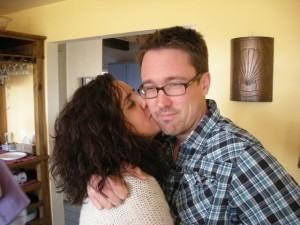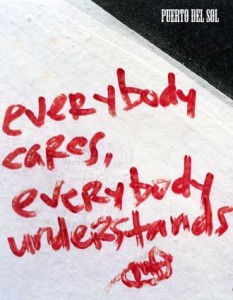Interview: Puerto del Sol
An interview with Carmen Gimenez Smith and Evan Lavender-Smith of Puerto del Sol, the journal of the English Department at New Mexico State University.
 Carmen Gimenez Smith is the author of Odalisque in Pieces (2009) and Bring Down the Little Birds (2010).
Carmen Gimenez Smith is the author of Odalisque in Pieces (2009) and Bring Down the Little Birds (2010).
Evan Lavender-Smith is the author of From Old Notebooks (2010) and Avatar (2011).
They run Noemi Press and edit Puerto del Sol and raise some kids. They both teach creative writing at New Mexico State University.
Puerto del Sol is “dedicated to providing a forum for innovative poetry, prose, drama, criticism and artwork from emerging and established writers and artists.”
Amy Ash: I know you both are very busy, so I want to thank you for taking the time for this interview. I’m currently reading Carmen’s latest book, Bring Down the Little Birds, which reflects on, and in many ways enacts the interconnectedness of writing and family. Evan, you explore many of these same concerns in From Old Notebooks. Could you both describe how your work and home lives intersect: How do you manage home life, university life, writing, editing, and publishing? What is it like working together as editors for Puerto del Sol?
Evan Lavender-Smith: Living with your co-editor is like living with your worst enemy. It’s like living and working in hell, right hon?
Carmen Gimenez Smith: We certainly have our arguments. Lately there isn’t really much distinction in our household between “work” and “play.”
ELS: Our son “plays” nowadays by making books and mucking around with different fonts on the computer. He’s something of a junior editor himself.
CGS: We should put him on the masthead.
ELS: Yes. Anyhow, I don’t know that “manage” is quite what we do. Between home stuff, teaching, editing, publishing and writing, something always has to give. For me, what gives tends to be writing. I’m always looking for excuses not to write, and these other things seem like pretty good reasons to me.
CGS: I think that what gives for you is also getting stuff done on time (by “stuff” I mean stuff in general, like everything).
ELS: I would agree with that, yes.
CGS: We work well together, though. Evan handles prose and design for the magazine; I handle poetry and publication. Two peas in a pod.
ELS: The pod of Puerto.
AA: According to the website, Puerto del Sol is in its 45th year of publication, and yet it feels so fresh, interesting and new. Could you please talk a bit about how the journal has evolved over the years and what keeps it current?
CGS: Puerto has always been a really strong journal, and I suspect this is in large part due to the dedication of student editors.
ELS: We’re lucky to have MFA students working on the journal who are paying attention to what’s going on in contemporary lit. I think the journal tastes as fresh as it does because we have some people here who are compulsive about keeping their fingers on the pulse of the culture, particularly of the so-called “indie lit scene.”
CGS: We have an amazing editorial team right now. Really bright people. People who genuinely care about putting out a quality journal. Evan and I are not the only editors at Puerto who lose sleep over making everything just right. Our staff is super dedicated.
AA: What role to these MFA students at have at the journal?
CGS: Their responsibilities include a bit of everything. Almost everyone who works on the journal reads from the slush pile.
ELS: Our two managing editors, Tracy and Mike Meginnis, have their hands in just about every every facet of the journal’s production. They represent a serious one-two punch for Puerto. I think the only thing that those two don’t do is typeset the book.
CGS: Mike and Tracy are amazing, yes.
AA: Since you have been working with Puerto del Sol, what changes have you seen in the type of work submitted? What advice do you have for writers who are interested in submitting to Puerto del Sol?
ELS: The submissions have just recently begun reflecting the slightly different direction we started moving in a couple years back, which is exciting; it suggests that people are actually reading the magazine … or at the very least are reading the table of contents.
CGS: How would you characterize this “slightly different direction”?
ELS: I would say that there is a new emphasis on publishing fiction and poetry and drama and nonfiction and even criticism the form of which seems somehow “unfamiliar” or “new.” I would say that the journal has taken a decidedly “Modernist” turn in many respects.
CGS: We also have many more submissions since introducing our online submission manager, and I think this has been good for the journal, despite there having been more submissions than we could handle even before online submissions. But I’m feeling like we’re finding some really top-notch stuff in the slush pile these days. I would, however, encourage potential submitters to look through very recent back issues in order to give themselves a better chance at acceptance.
AA: One of the things I enjoy most about Puerto del Sol is its variety. As you’ve mentioned, you accept submissions for poetry, drama, fiction, non-fiction, translations, artwork, and criticism, and welcome combinations of these genres. Many journals out there stick to the basic three: poetry, fiction, and non-fiction, or are even limited to just poetry and fiction. How does the variety within Puerto del Sol relate to its overall aesthetic?
ELS: This was a big concern coming in. We wanted to do all sorts of stuff. The poetry-fiction model works great for some journals, but I think our interests as writers and readers are diverse in such a way that we feel some amount of confidence weighing in, editorially, in ways that many lit journals don’t.
CGS: We’re interested in different kinds of things (fiction, nonfiction, reviews, theory, poetry, etc.), absolutely; but we’re also interested in single works that attempt to step outside the constraints of genre.
ELS: That’s right. I’d like to imagine Puerto as a journal in which you turn from a fiction to a poem to a theoretical essay to a personal essay to a play to a book review to something that defies categorization altogether.
AA: One of the great things about the website for Puerto del Sol is the page that provides links to other periodicals and presses. How do these publishers and publications relate to the “indie lit scene” that you’ve mentioned, and how important do you feel it is to emphasize and acknowledge a larger community of writers in this way?
ELS: I wanted that links page to serve as something like a gateway to the independent publishing community as I see it. I remember coming upon some lists like that when I was just getting started as a writer and feeling so grateful. I hope the links page will prove useful to young writers looking for a community of journals and presses tending toward innovative writing.
CGS: There’s some really great stuff on there. Most all of those presses and journals relate to the independent publishing in one way or another.
AA: What is the relationship between Puerto del Sol and Noemi Press?
CGS: We often find things we like at one and follow up at the other: writers, editors, marketing ideas, design ideas. It’s nice having two places we can bounce ideas between; we can make a mistake at Noemi and then fix it at Puerto, or vice versa.
ELS: Or we can do something just perfectly at Puerto and repeat it at Noemi, or vice versa.
CGS: Of course.
AA: What do you see for the future of Puerto del Sol? For Noemi Press?
CGS: I see them both getting better and better. Our biggest challenges right now are money— especially with Noemi; thankfully Puerto has funding through New Mexico State University—and time. I imagine money will always be a big challenge; time is something we can help by surrounding ourselves with smart, industrious editors.
ELS: Carmen and I have a tendency to overextend ourselves and then drown. The nice thing about bringing other people into the fold is we can commit to things like crazy and then slough them off on unsuspecting junior editors while we go off on vacation.
CGS: Hmmm … I don’t believe we have been on vacation since we met.
ELS: She was asking about the future, though.
CGS: I’ll believe it when I see it.
Amy Ash, a graduate of the MFA program at New Mexico State University, is a PhD student in Creative Writing at the University of Kansas. Her poems have been published in various journals, including Lake Effect, Cimarron Review, Harpur Palate and Mid-American Review.

